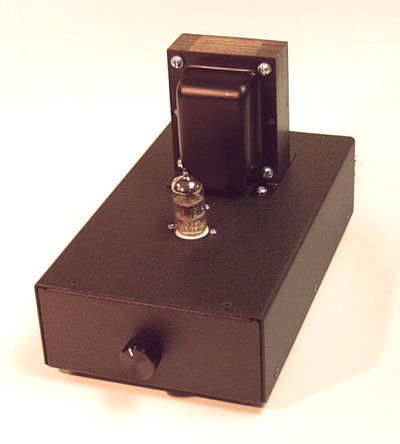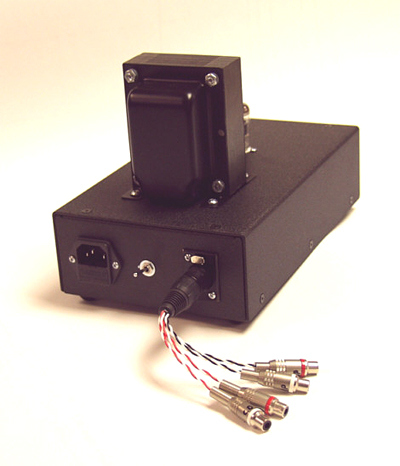You are reading the older HTML site
Positive Feedback ISSUE 9
october/november 2003
decware
ZSLA-1 preamplifier
as reviewed by Francisco Duran

FRANCISCO DURAN'S SYSTEM: LOUDSPEAKERS ELECTRONICS SOURCE CABLES ACCESSORIES
|
The Decware ZSLA-1 is a single-ended buffer stage preamplifier using a single dual-triode tube. Decware sent three different tubes to try out with this unit: a 6DJ8, a 6922, and a 6N1P. It proved to be both interesting and fun to "roll" these tubes. Steve Deckert, owner of Decware, stated in a letter to us that "the 6N1P tube is well balanced, somewhat warm and smooth sounding." This is exactly how I heard it, and why I used it throughout my listening sessions.
Despite the fact that this preamp has a larger-than-life power supply, it is a small fry. It can be held in the palm of your hand, but don't let its Mini-Me stature fool you. With one input and a single pair of outputs, it also qualifies in the minimalist category. There is a volume knob on the front, but no power indicator. That duty falls on the tube—if it is glowing, the unit is on. This falls right into place with the ZSLA-1's simple and straightforward design. The manual suggests that the unit can be left on indefinitely without damage, and used this way, "tube life will not be damaged from constant operation." I won't argue with that. The ZSLA-1 operated very quietly and ran cool to the touch, even after it had been on for days.
This well-built little beast is finished in a rugged powder coat black. My wish would be for Decware to offer it in a variety of colors, along with a transformer cover and perhaps a fancier volume knob. Then the ZSLA-1, instead of being an ugly duckling, would become the cool centerpiece of an audio system. As it is, the preamp will have to win hearts on its merits.
Look around the back of the unit, and all you see is a power cord receptacle, an on/off switch, and an XLR input. No RCAs. You get a pigtail of wire that has an XLR connector on one side, and the other end has four lengths of female-RCA-terminated wire about five inches long. The wire is high quality silver/Teflon. The idea is to connect your interconnects to this pigtail, one set going to the amp and the other to the lone source. The reason for the XLR connection is its improved grounding scheme. Decware also offers this same pigtail in a male-terminated, one-meter length, so you can bypass your existing interconnects altogether. This way, you avoid breaking the connection from preamp to source/amp, and eliminate four of the eight female RCAs. After connecting my stiff and unwieldy JPS cables to the flexible Decware pigtail, the fear of breaking a wire always crept in the back of my mind, but I am happy to report that none was damaged.
To quote from the instruction manual: "The odds of most people having interconnects that sound better are slim, which is why we offer this integrated set." I didn't have the one-meter set, so can't comment as to its performance versus my JPS. As for power line conditioners: "to date, the only line conditioners we know of that make a profound difference are made by PS Audio." I have tried the PS Audio units and they are very good, but in my system the ZSLA-1 was plugged into a Balanced Power Technologies 4SE, which made a profound difference.
Decware makes a number of upgrades available, including a stepped Alps carbon pot, pure silver Litz internal wiring, and Wima Signature coupling caps. They also warn against modifications. As rugged as this thing is—not to mention the fact that it runs cool and has one of the simplest of signal paths—what can go wrong? Why modify? Just crank the music and have some fun!
My Reference Line 1A passive preamp has a very clean sound, minus a little of what I call dynamic expansion, in which the soundstage and dynamics have a stronger sense of heft at the frequency extremes. This is where the active, tube-based Canary CA 601 Mk. II takes over. The Canary is also a little more detailed and warmer sounding than the Reference 1A. Both preamps have four inputs and two outputs. With its single input and output, I was hot-rodding it with the ZSLA-1, baby!
With the Decware preamp hooked up to any of my amps, I heard no noise, hum, or
buzz of any kind. On the CD Wanting, from the Brazilian beauty Gabriella Anders,
her  voice was
delicate and sweet. Songs like "Brasileira" or "Fire of Love" sounded
captivating. The ZSLA-1 brought out the subtle character of her voice with ease. The
dynamics of her breathing, and the subtle emphasis on words when she sings, was fun to
follow. Derek Trucks and company feature the voice of Solomon Burke on two cuts from the
CD Joyful Noise. On the songs "Home in Your Heart" and "Like Anyone
Else," Burke's voice was powerful and commanding. When he emphasized a note or word,
I felt it! Part of the joy of listening to these songs is the way in which Trucks'
stinging lead guitar, Kofi Burbridge's organ growls, and Burke's soulful vocals bounce off
of each other.
voice was
delicate and sweet. Songs like "Brasileira" or "Fire of Love" sounded
captivating. The ZSLA-1 brought out the subtle character of her voice with ease. The
dynamics of her breathing, and the subtle emphasis on words when she sings, was fun to
follow. Derek Trucks and company feature the voice of Solomon Burke on two cuts from the
CD Joyful Noise. On the songs "Home in Your Heart" and "Like Anyone
Else," Burke's voice was powerful and commanding. When he emphasized a note or word,
I felt it! Part of the joy of listening to these songs is the way in which Trucks'
stinging lead guitar, Kofi Burbridge's organ growls, and Burke's soulful vocals bounce off
of each other.
 The
dynamic expansion of the ZSLA-1 carried over into the lower region as well, but a
qualification is in order. My Spendor 2/3s have pretty good bass extension when called
upon. but you can only get so much bass from a pair of stand mounted, two-way speakers.
Once again, the dynamic shadings and contrasts were fun to listen to. The Decware preamp
reached down and grabbed dynamics with a solid grip. "Why Me Lord," one of my
favorite tracks on the CD Hotshot, by Shaggy, passed through my speakers with
precision and speed. This preamp is not sluggish in any way. Looking at it and listening
to the music coming out of it seemed like two different realities. I kept asking myself,
"How does such a big sound come out of something so small?"
The
dynamic expansion of the ZSLA-1 carried over into the lower region as well, but a
qualification is in order. My Spendor 2/3s have pretty good bass extension when called
upon. but you can only get so much bass from a pair of stand mounted, two-way speakers.
Once again, the dynamic shadings and contrasts were fun to listen to. The Decware preamp
reached down and grabbed dynamics with a solid grip. "Why Me Lord," one of my
favorite tracks on the CD Hotshot, by Shaggy, passed through my speakers with
precision and speed. This preamp is not sluggish in any way. Looking at it and listening
to the music coming out of it seemed like two different realities. I kept asking myself,
"How does such a big sound come out of something so small?"
If the treble ranges of a given piece of equipment are neither bright or thin or rolled off, I focus less attention on this part of the music. So it was with the ZSLA-1. Words like "smooth", "detailed," "clear," and "extended" would be appropriate in describing its top-end performance. Words like "glare," "grain," or "bright" definitely do not. While the ZSLA-1 was very revealing, it did not spotlight any part of the frequency range of the music. Although high frequencies were extended, they were also non-fatiguing, even in long listening sessions. Piercing rock guitars or high hat and cymbals sounded both detailed and natural.
A direct comparison with my Canary preamp was interesting. The Canary came off as more polished and warm. Rimshots on a drum kit sounded weightier. On the other hand, the Decware had very nice bloom, and transients were vivid and clean. The ZSLA-1 sounded more textured, but less colored than the Canary, and edged out the Canary in its ability to flesh out clear, clean images. In this respect, the ZSLA-1 reminded me of the Lamm preamp that we reviewed a while back. The extended soundstage and holographic images were clearer in the soundtrack to the movie Frida than with my regular gear. This aspect of the ZSLA-1's performance was most impressive.
The ZSLA-1 is an ugly duckling. It only has one input. It doesn't even have a little blue light to tell you it is on, much less a transformer cover. However, this little puppy can play music. It has a very clean sound, with just the right amount of warmth to be inviting and not sound colored. It has dynamic authority that equals that of line stages costing many thousands of dollars. If you value musical performance and economy over features, this unit should definitely be on your audition list. It is also so inexpensive that you can keep it around to remind your audio buddies just how good a line stage should sound. Francisco Duran

ZSLA-1
preamplifier
Retail: $575
Decware
web address: http://www.decware.com
